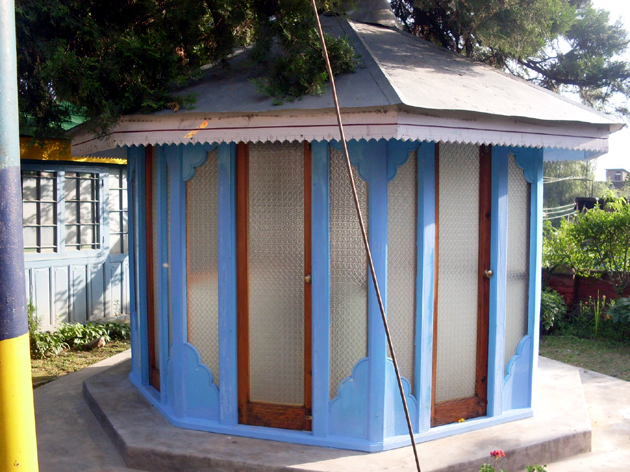M K Mattoo
From remote past religion has always dominated the life of Kashmirian, and Kashmir has always been a holy land abundantly endowed with holy sites and objects of pilgrimage. Kalhan speaks of it, as a country “where there is not a space as large as a grain of sesame without Tritha”. According to Abu-Fazal (16th Century) ” The whole of Kashmir is considered to be holy ground by the Hindus, there are one hundred thirty four shines dedicated to Hindus deities”. Besides the Tirtha, there is hardly a village or place which has not its sacred spring and one among them is Ishbar (Gupt Ganga)—a sacred spring of great fame and faith.
According to Stien, the present village of Ishbar which lies two miles further north on the Dal Shore and a little beyond the picturesque “Nishat Moughal Garden and 1½ miles from “Shalamar Bagh” a Moughal Garden to the south, is a sacred site ‘Gupt Ganga’ of a great fame.
In ancient times, it was known as “Suresvarikstra” (The field of Suresvari). Abu-Fazal says that it was held sacred by the people of Hindustan. It was also called by the name (Sur-ya-Sar) means surrounded by stone temples. According to Ariel Stein, Ishbar was holiest pilgrimage place and was frequently visited by the pilgrims in his time. The holiness of Suresvari is also mentioned in Kalhan’s chronicles and other texts as a place, “where a person would prefer to die for Moksha”.
This Tirtha was sacred to Durga Suresvari who was worshipped on a high mountain crag to the east of Ishbar, about 3000 feet above Ishbar village. As the rugged rock on which seat of Goddess was located, could not offer any space of construction of any building, several shrines in her honour were erected at the gentle slopes on the foot of the mountain which extended upto the shore of the Dal Lake. The pilgrimage to Suresvari necessitated visit to several springs in and around Ishbar. The famous one, being Sata-dhara! It lies in a narrow gorge some 1500 feet below the rock of Suresvari.
Immediately behind the tank is a ruined mound with its base formed of carved stone-slabs of antiquity. It marks the site of a temple built by king Samdhimat, alias Arya-raj (69-22 BC) in honour of his Guru Isana, the famous saint of his time, who cared much for spiritual attainment rather than for material objects. Thus he could not look after the affairs of his kingdom. This discontentment later , resulted in revolt in which he was made a prisoner. When the Samdhimat was put on cross, the great guru Isana came and saw three sentences projected on the forehead of the prisoner (Samdhimat). These are, “This man will lead an austere life, he will be put on the stake; After resurrection, he should be the King.
On the third day, Samdimat came to life and was again invited to kingship but he refused. He was forced to abdicate by the people of Kashmir. He became a hermit and lived in Ishbar before he went to Bumzo cave which is situated in Pattan, where he breathed his last. The temple he built for his Guru Isana is no longer in existence. This temple was called (Ises-vara) and from this emerged Ishbar. The another version is: once Parvati was in search of her separated consort Shiva, who was at Mount Mahadev (a mountain ahead of the village) she arrived at this place and dropped a few tear-drops in his memory. These tear-drops formed into springs, which was later-on known as Ishbari (Gupt Ganga).
The chief attraction of Ishbar is a sacred spring known as Gupt Ganga, which fills an ancient stone-lined tank in the centre of the village. There are other springs, two adjacent to each other and one near the road. The smaller of the two about 4 x 4 meters has three three idols of Shiva, Parvati and Ganesh in it. The large spring (tank) is 101/2 x 101/2 meters. The water of the two mixes with each other. The third, adjacent to the wall behind the road is 8 x 8 meters but is not maintained properly and has over-growth of grass a around tank. Its water flows out into the Dal Lake Shore beneath the soil. It is unique and its water is pious as water of Ganga. Not a single drop of water flows out from it. It is very deep in centre.
A little beyond these springs on a high level is (Surveshvara) temple of Shiva and Parvati with a high Lingam of about 4 feet build by Prince Suraverman son of king Avanti Varman. There are many other buildings for the use of ascetics in the village Ishbar. A temple is decorated with paintings of Lord Shiva and Parvati on the walls inside. It is an ancient temple, having a huge land, surrounded by number of Chinar trees but their number has considerably reduced. Those who remain however, are in fine condition. There are few buildings around and an apple orchard in front of temple. Whosoever sits in its side in a devotional prayer gets entranced and spiritually transformed. The people of village and pleasure seekers spend their leisure time here. Now, the condition of the garden after migration is not better than of a playing field and gives a picture of decay as witnessed by the writer. Gone are the days when we used to come once in a week for paying obeisance and darshan of Lord Shiva.
Every year on 1st Baisakhi (Vashki), a fair was being celebrated by Kashmiri Pandits. A fair was held at Ishbar, where people generally bath and the visit the nearby Nishat Garden or Shalimar Garden for a picnic. It is from that day, that officially fountains and cascades begin to play officially in the various old Mughal gardens for ensuing season. It was fair of communal harmony and brotherhood of Muslims and Hindus.
Trending Now
E-Paper


